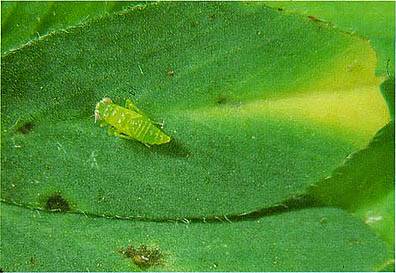Boron deficiency in alfalfa is characterized by a yellowing or reddening of the upper leaves of the plant, and is sometimes referred to as “yellow top”. Boron does not translocate within the plant so newer growth on the top of the plant is yellow, while older lower leaves will stay green. The field, or patches in the field, assume a bronze color. (Figures 1 & 2) Stem growth between leaves becomes shortened, giving plants a stunted, bunchy appearance. Alfalfa growth can be severely stunted with reduced yield, nutrient quality and winter hardiness. The yellowing caused by boron deficiency during dry weather is often incorrectly dismissed simply as “drought damage”.
Boron deficiency in alfalfa shows up mainly on higher pH (pH > 7.0), low organic matter, sandy-loam soils and is seen most frequently on droughty soils under dry conditions. Organic matter is normally the source of available boron to the plants. In Ontario, boron deficiency is more commonly seen east of the Niagara escarpment.
Figure 1 – The alfalfa field, or patches in the field, assumes a bronze color.
Figure 2 – Boron deficiency is characterized by a yellowing of the upper leaves of the plant, and is sometimes referred to as “yellow top”. Lower leaves will stay green.
Diagnosis
Boron deficiency symptons in alfalfa are sometime confused with potato leafhopper (PLH) damage. However, with boron deficiency the discolouration appears on leaves at the top of the plant, while with PLH the discoloration appears on both the upper and lower leaves. PLH leaves a distinctive V-shaped hopperburn on leaf tips. (Figures 3 & 4)
Soil testing is not considered very reliable for determining boron deficiency. Tissue testing of alfalfa (at mid-bud to early-flower stage) with a properly taken sample and laboratory analysis is a suitable diagnostic approach for confirming boron deficiency. Sample the top 6 inches of 35 – 40 stems, let them dry, and send them to a laboratory for tissue analysis. The critical level below which alfalfa is considered boron deficient and will benefit from applying boron is 20 ppm. If a check is desired, take a similar sample from an area with no visual boron deficiency symptoms. Under good growing conditions when yellowing symptoms are not visual, tissue testing may not show deficiency, but will show deficiency in seasonal dry conditions when symptoms are evident.
Applying Boron
Boron deficiency can easily usually be corrected or prevented by a broadcast application of 1 – 2 lbs/acre of boron blended with the phosphate and potash. Other crops have low tolerances to excessive boron application, so be careful not to over apply. Do not band apply boron. Refer to OMAFRA Publication 811, Agronomy Guide For Field Crops, p. 68. (http://www.omafra.gov.on.ca/english/crops/pub811/3fertility.htm#micronutrients)
Figure 3 (left) – Boron deficiency appears on the upper leaves of alfalfa, becoming yellow to red.
Figure 4 (right) – Potato leafhopper damage “hopperburn” symptoms start as a “V” yellowish pattern on the leaf tips, appearing on both the upper and lower leaves. (Photo credit – OMAFRA)








